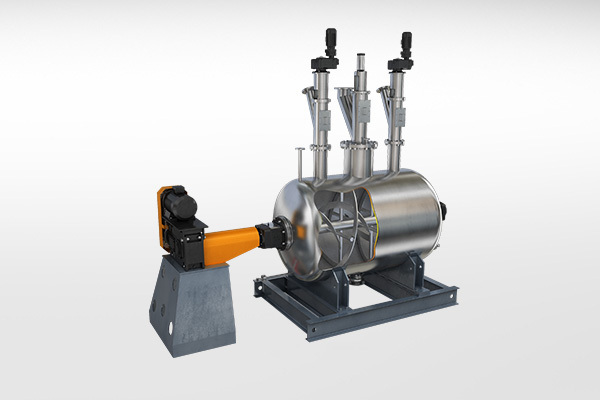
19
2021
-
10
Introduction for All-in-one vacuum reacting plough mixer
Vacuum Mixing Reactor / All-in-one Mixer
During industrial production process, chemical reaction usually covers multi-stage processes, including the synthesis process itself and other relative processes before and after. The technology of vacuum mixing reactor makes it possible to perform several of these steps in the same machine.
Typical Case
Solid-liquid reaction is one of the most important chemical reactions, which usually require close contact between solid and liquid reactants to achieve quantitative conversion in the shortest possible time. This article will introduce the production of calcium soap in details.
The reaction and vacuum drying process will be completed in the mixing reactor at the same time. Calcium soap is hydroxides made from fatty acids and metal oxides or other substances. Chemically, this conversion is a typical acid-base reaction. The fatty acids used are usually derived from vegetable fat or oil. Technically an important component of calcium soap is Metal Stearate, which has industrial applications with different properties. Calcium Stearate, Zinc Stearate or Magnesium Stearate are used as lubricants and separating agents, stabilizers or lubricants hydrophobic agents, etc.
Fatty acids and metal oxides or hydroxides are all solids, but at the molecular level, the mobility of ions in the solution is insufficient for these solids to react with each other in an acceptable time. To increase their speed and reactivity, it is necessary to add water. When temperature of added water reaches 150°C, the exothermic reaction takes only a few minutes. To achieve complete conversion, intensive mixing is essential. This is the only way to ensure that all fatty acid particles are in full contact with metal hydroxide and water so that the reaction can take place.
Since calcium soaps are usually further developed to anhydrous solids, it is necessary to use dry products to remove the added water and by-products of the water reaction. After the chemical reaction, the pressure gauge releases the pressure in the reactor and adjusts to vacuum condition. The agitating element ensures turbulent mixing and good heat transfer. This makes calcium soap dry gently and quickly for its wet surface. The high-speed choppers on the side of the reactor can break any lumps so that the water in them can also be quickly removed.
Structure and Principle
The mixing reactor is composed of circular cylinder, plough agitator, high-speed choppers, drive system, external jacket, pulse dust collector and discharge valve. During operation, the material will form centrifugal throwing convection, and the high-speed choppers can break the material that easy to agglomerate. The mixer vessel body can meet the conditions of full vacuum and pressure release during reaction process. In addition, the external jacket can heat the material to achieve the required temperature for reaction. During reaction there will be hot air and dust, the dust collector on top of the mixer separates gas and solid powder, and pump out the moisture to speed up the drying. We design enough power and VFD (Variable Frequency Drive) motor to cope with different shaft speed in the reaction. In the case of the most severe reaction, the shaft runs at a low speed and the torque reaches its peak. At the end of the reaction, the shaft speeds up to reach the final mixing uniformity.

Flow
Following is detailed flow drawing with process of reacting, mixing, liquid adding, drying, cooling, milling.


Summary
After the liquid-solid chemical reaction, the product is usually dried as the second processing step after reacting. These two steps can be operated on one machine as customer required. Our mixer can cover all pressure and temperature ranges that appear in the entire process, and can also be customized according to the specific situation that covering a wide range of different applications.
Application
Foodstuff industry (drying)
Plastics industry (drying, coating, cooling)
Chemicals industry (drying, cooling, pelleting, extracting)
Environmental protection industry (drying, pelleting, extracting)
Pesticide industry (drying, cooling, coating)
Building materials industry (drying)
Metallurgy/ mining industry(drying, cooling, pelleting)
Keyword:



